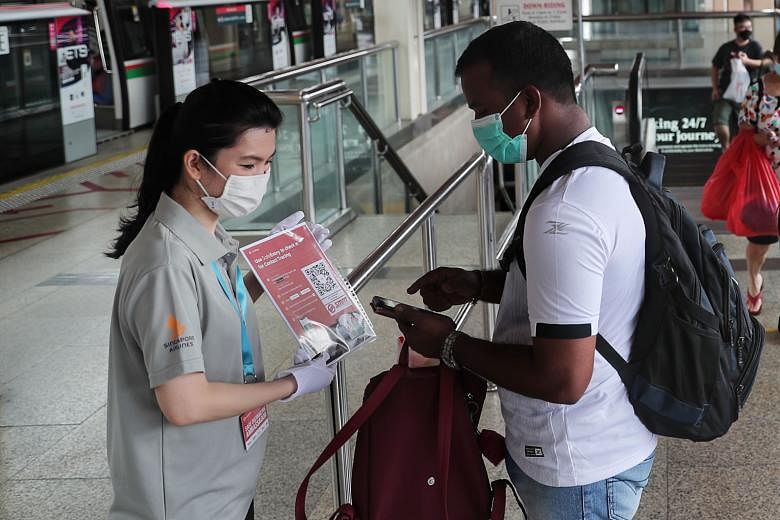It is a common sight at train and bus stations: Commuters walk past the QR code on display without scanning it. Even on taxis, few people scan the QR code to log their entries and exits by supplying the Government with their contact information and identity number.
The common refrain: "It's too cumbersome, and I'm in a rush."
One commuter, who wants to be known only as Mr Ng, said: "It is not compulsory."
Indeed, observers have criticised the SafeEntry QR code check-in system for being "leaky" as it does not capture community movement well, especially in public transport networks, where the risk of Covid-19 transmission is high.
"Even in some buildings where SafeEntry's use is compulsory, I see people waltzing past security without having scanned the QR code," says Professor Leong Thin Yin from the Singapore University of Social Sciences' business programme.
Singapore has 2.2 million users for national contact-tracing app TraceTogether, launched in March.
But it is still not large enough for effective digital tracing; experts have said at least three-quarters of the population, or 4.2 million people, need to be users.
Last month, the nation rolled out a wearable device called TraceTogether Token, which works in similar ways to the app by using Bluetooth signal exchanges to log nearby users.
Priority is given to seniors without smartphones. But only 10,000 tokens have been issued so far. More are expected next month.
FIXING DIGITAL CONTACT-TRACING GAPS
As the threat of a second wave of infection looms large, experts say it is time to ramp up digital contact tracing by plugging existing gaps.
Already, infection clusters have popped up relentlessly and led to a resurgence of the Covid-19 virus in places such as Hong Kong, Japan and Australia - forcing the authorities there to reinstate movement curbs and business shutdowns.
Digital tools can quicken the contact-tracing process to just a day from a few days, as contact tracers rely less on the tedious process of scanning closed-circuit television footage and interviewing patients and their contacts to figure out who had been exposed to the virus.
In the absence of mass testing and a vaccine, such tracing technologies are key to preventing widespread community transmission and a second circuit breaker in Singapore as potentially infected people can be quickly quarantined.
One obvious gap is the absence of digital contact tracing in public transport systems.
"Have you wondered why the places frequented by Covid-19 cases never include public transport?" Prof Leong asks, pointing out that these cases were perhaps not being captured in the first place.
SafeEntry has been installed at 200,000 locations, including malls, workplaces, cabs and public transport - but its use is only enforced in some places.
There will be no need to deploy enforcement officers if the tool is simplified.
Prof Leong suggests the use of a "static" contact tracing token installed at premises to automatically record check-ins.
This will be similar to what urban and infrastructure consultancy firm Surbana Jurong is trialling at a construction site it manages in Tampines.
Surbana Jurong is using Temasek-owned D'Crypt's contact-tracing token called BluePass, issued to 400 workers to log their social encounters. A version of BluePass is also installed throughout the site to log entries and exits.
"If static TraceTogether tokens are placed at the entry and exit points of premises, visitors can be effectively recorded," says Prof Leong. But this works only when the TraceTogether Token or app is widely used.
The Bluetooth signal strength recorded between the contact-tracing apps and devices estimates the distance between users and duration of encounters.
People within 2m of a Covid-19 patient for 30 minutes will be put under quarantine.
IMPROVE PARTICIPATION RATE
Digital contact tracing participation can be improved in two ways: Make TraceTogether compulsory in some instances, such as when seeking to gain entry to venues, and integrate it with tokens created by the private sector.
"Just as we need to flash SafeEntry passes to go into a supermarket, we could show we have activated the TraceTogether app or the token if we want to enter certain places or when taking public transport," says Associate Professor Alex Cook, vice-dean of research at the National University of Singapore's (NUS) Saw Swee Hock School of Public Health.
He cites the example of NUS, which has mandated the use of TraceTogether among teachers and students.
"I'm in favour of invasive contact tracing during a serious infectious disease outbreak such as this one, because the risk of a loved one taking seriously ill or dying outweighs the loss of privacy. We implicitly accept this trade-off by using SafeEntry to enter shops or restaurants," says Prof Cook.
Users of TraceTogether and SafeEntry have to provide their full identity number - NRIC, FIN or passport - and mobile number to the authorities, who had said the information would be protected and not used unless necessary.
D'Crypt chief executive Antony Ng suggests that the Government share the communications protocols of TraceTogether with private sector developers so that different contact-tracing tokens can "talk" to one another.
"Having multiple parties manufacture and distribute these devices will ensure more people receive the devices for better contact tracing," says Mr Ng.
There are plans for BluePass to be rolled out to 30,000 workers at the 15 construction sites Surbana Jurong manages as early as next month. D'Crypt is also in discussions to pilot BluePass in the petrochemical, medical equipment manufacturing, maritime and construction industries.
A spokesman for the Smart Nation and Digital Government Group, which is behind the national contact-tracing technologies, tells The Sunday Times: "We are open to greater private-public sector collaboration, and are exploring ways in which we can work with the industry on the TraceTogether programme to improve our digital contact-tracing tools."












